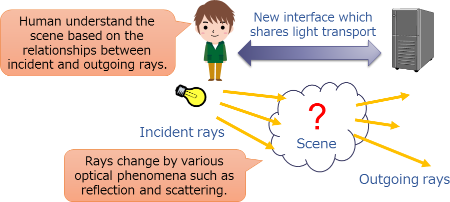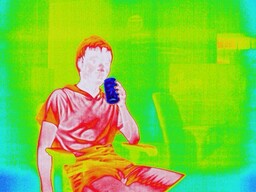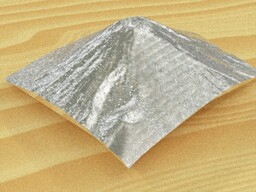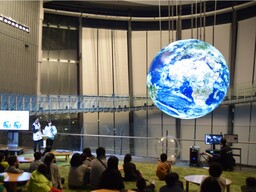Mission of our lab
Light rays emitted from a light source reaches our eyes
after reflecting on surfaces,
refracting as they enter or leave glasses,
and scattering inside translucent objects in a scene.
By merely looking at an object,
we humans can recognize not only the surface physical condition
(i.e. roughness and shininess)
but also various object properties that influence the impression of the object.
Thus, light must serve as a medium
that conveys various significant information about the scene.
Our challenge is to develop an interface,
which we name the "Optical Media Interface",
to share scene information
between humans and computers based on the light transport.
The aim of our research is to
provide computers with the capability to understand scenes through the
"Optical Media Interface".

Computer Vision
We are developing technologies that enable a computer to understand a scene by estimating the 3D shape and material of an object based on visual information captured by a camera. To achive this, we utilize not only conventional cameras but also specialized cameras, such as far-infrared cameras, hyperspectral cameras, and Time-of-Flight cameras. The optical information obtained by these cameras is analyzed using both physical models and deep learning. This technology is needed in industries such as autonomous driving and product inspection.


Computer Graphics
We develop techniques to render realistic CG that depict the unique texture of an object by reproducing reflections and scattering of light, making it indistinguishable from the real thing. We also aim to develop new ways of presenting visual information beyond merely displaying CG on a screen, such as creating realistic replicas, stereoscopic viewing, and projection mapping.


Computational Photography
Cameras can achieve greater functionality by incorporating computational processing into photography. This involves not only image processing but also optical innovations that can surpass the physical performance limits of the device. This capability allows for capturing images that are impossible with ordinary cameras. This technology has been recently implemented in smartphones.


Development of Sensing System
We specialize in designing and developing sensing systems that measure various properties of light rays in a scene, including position, angle, Time-of-Flight, wavelength, and more. By combining different optical elements, such as lenses, reflectors, and light sources, we create unique systems tailored for specific purposes.

